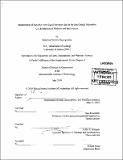| dc.contributor.advisor | Dara Entekhabi and Kelin X. Whipple. | en_US |
| dc.contributor.author | Spyropoulou, Katerina Dimitris, 1977- | en_US |
| dc.contributor.other | Massachusetts Institute of Technology. Dept. of Earth, Atmospheric, and Planetary Sciences. | en_US |
| dc.coverage.spatial | n-us-ca | en_US |
| dc.date.accessioned | 2006-11-06T18:16:16Z | |
| dc.date.available | 2006-11-06T18:16:16Z | |
| dc.date.copyright | 2003 | en_US |
| dc.date.issued | 2003 | en_US |
| dc.identifier.uri | http://hdl.handle.net/1721.1/34350 | |
| dc.description | Thesis (S.M. in Geosystems)--Massachusetts Institute of Technology, Dept. of Earth, Atmospheric, and Planetary Sciences, 2003. | en_US |
| dc.description | Includes bibliographical references (leaves 34-36). | en_US |
| dc.description.abstract | The identifiable pattern of the qualitative geomorphologic parameters such as steepness and concavity values that derived from the slope-area analysis of 28 tributaries in the San Gabriel Mountains were used to estimate relative rock uplift rates. The results suggest that the eastern region of the San Gabriel Mountain is controlled by a high rock uplift rate while the western region is controlled by a low rock uplift rate. Furthermore, arrangement of the variations of the steepness and concavity values suggests the presence of an active fault zone between the western and the eastern region of the San Gabriel Mountains. This tectonic zone is responsible for the apparent differentiation in rock uplift rates between the two mountain regions. This conclusion is supported from previous knowledge that suggests faster exhumation and high erosion rates of the East San Gabriel (ESG) block and slower exhumation and lower erosion rates of the Western San Gabriel (WSG) block (Spotila, J., Blythe, A., House, M., Niemi, N., Gregory, B., 2002). Moreover on the technological side of this project, plots of steepness or concavity values derived from analysis of SRTM (30 meter resolution), ASTER (30 meter resolution), USGS (30 meter resolution) and USGS (10 meter resolution) DEMs analysis suggest that USGS DEM-10 meters and SRTM DEM-30 meters are currently the most accurate methods to accurately quantify differential steepness and concavity values for the area of the San Gabriel Mountains in Southern California. Finally, the application of different smoothing options on the plots of slope-drainage area analysis of the tributaries of the San Gabriel Mountains suggests that a 600 meter window size is the optimum size with more reliable information and better noise elimination. | en_US |
| dc.description.statementofresponsibility | Katerina Dimitris Spyropoulou. | en_US |
| dc.format.extent | 61 leaves | en_US |
| dc.format.extent | 5823318 bytes | |
| dc.format.extent | 5825798 bytes | |
| dc.format.mimetype | application/pdf | |
| dc.format.mimetype | application/pdf | |
| dc.language.iso | eng | en_US |
| dc.publisher | Massachusetts Institute of Technology | en_US |
| dc.rights | M.I.T. theses are protected by copyright. They may be viewed from this source for any purpose, but reproduction or distribution in any format is prohibited without written permission. See provided URL for inquiries about permission. | en_US |
| dc.rights.uri | http://dspace.mit.edu/handle/1721.1/7582 | |
| dc.subject | Earth, Atmospheric, and Planetary Sciences. | en_US |
| dc.title | Interpretation of tectonics from digital elevation data in the San Gabriel Mountains, CA : evaluation of methods and data sources | en_US |
| dc.type | Thesis | en_US |
| dc.description.degree | S.M.in Geosystems | en_US |
| dc.contributor.department | Massachusetts Institute of Technology. Department of Earth, Atmospheric, and Planetary Sciences | |
| dc.identifier.oclc | 54534988 | en_US |
